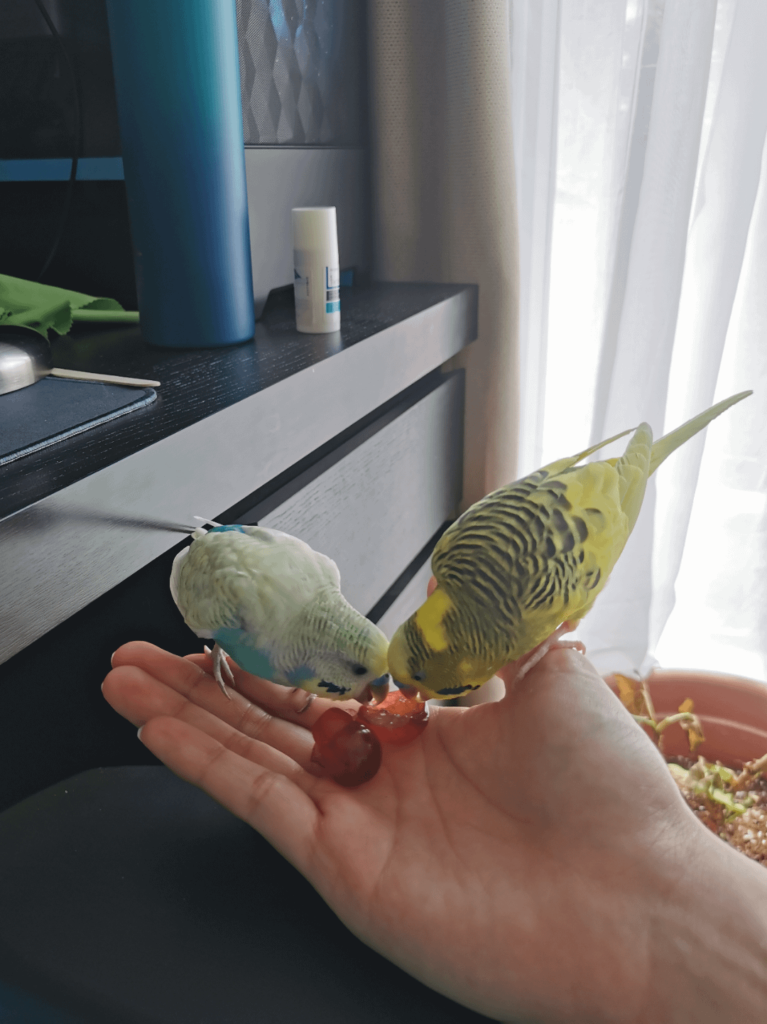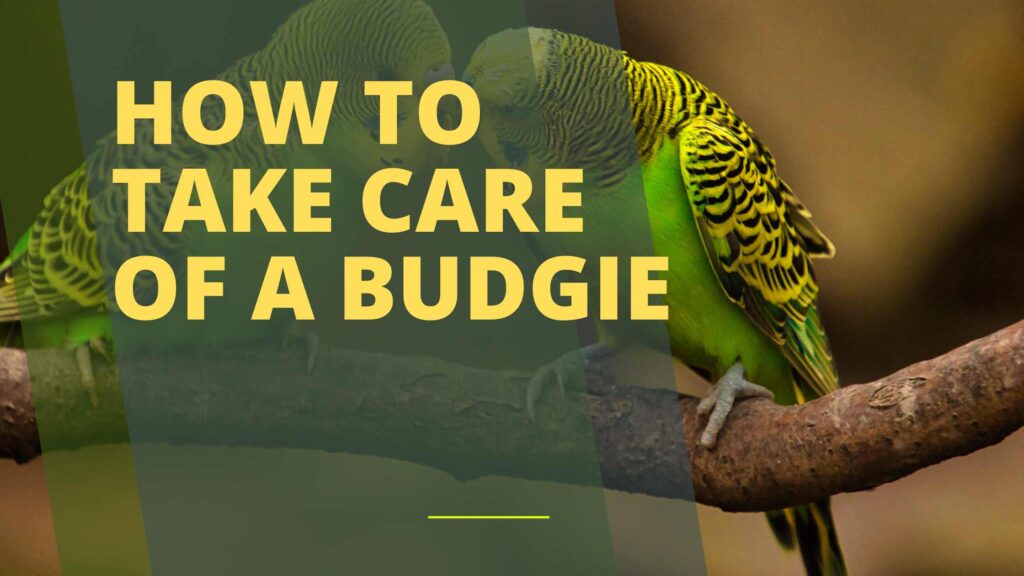To properly care for a budgie, provide a spacious cage and a balanced diet of seeds, fresh fruits, and vegetables. Ensure its environment is safe, comfortable, and engaging with toys and perches.
Budgies, also known as parakeets, are popular pets known for their vibrant personalities and ability to mimic human speech. These small, social birds hail from Australia and thrive in environments that closely mimic their natural habitat. Setting up a suitable home for your feathered friend is crucial; it starts with choosing the right cage, which should be large enough for flight and outfitted with various perches of different thicknesses to promote healthy feet.
How to Take Care of a Budgie?
A consistent supply of fresh water and a varied diet that includes specialized pellets, as well as fresh produce, is essential for their health. Regular, gentle interaction helps to maintain their social nature and prevents boredom, while daily cage cleaning wards off diseases. By meeting these care requirements, you ensure that your budgie remains a chirpy and healthy companion.

Introduction To Budgie Care
Embracing the joy of budgie ownership means understanding the special care these colorful companions need. Whether you’re a seasoned bird enthusiast or a new pet parent, this guide will outline the essentials for your feathered friend’s happiness and health.
Why Budgies Make Wonderful Pets
Budgies, or budgerigars, fascinate with their vivid colors and cheerful chirps. Compact in size, they fit comfortably in cozy homes. They bond deeply, learning tricks and even speaking words. These traits make them delightful family pets.
Essential Needs Of A Healthy Budgie
- Spacious Cage: Room to fly for daily exercise.
- Balanced Diet: A mix of seeds, fruits, and vegetables.
- Hygiene: Regular cage cleaning and fresh water.
- Stimulation: Toys and interaction for mental health.
- Company: Consider a second budgie for companionship.
- Veterinary Care: Annual check-ups and prompt illness treatment.
Setting Up A Comfortable Habitat
Creating a loving home for a budgie starts with the perfect habitat. This guide simplifies the process and ensures a cozy, safe environment for your feathery friend.
Choosing The Right Cage
A budgie’s cage is its castle. Select a cage with ample space, proper bar spacing, and secure locks. Look for:
- Size: At least 18x18x24 inches for one budgie.
- Bar Spacing: No more than 1/2 inch apart.
- Shape: Rectangular cages offer more flying space.
- Accessories: Including perches and feeding bowls.
Ideal Location In Your Home
Position the cage in a room that’s lively but not loud. Key factors include:
- Light: Natural, indirect sunlight promotes a healthy sleep cycle.
- Temperature: Keep away from extreme hot or cold spots.
- Interaction: A family room corner allows for socialization without overwhelming.
- Safety: Away from pets, fumes, and windows.
The Essentials Inside Their Cage
Creating a cozy and stimulating environment within your budgie’s cage is pivotal for its happiness and health. A proper setup not only ensures comfort but also promotes essential physical and mental activity. Here, we’ll delve into what makes a birdcage suitable and safe for your feathered friend.
Perches And Toys: Variety And Safety
Budgies need perches of varying sizes and materials to keep their feet healthy. Let’s look at how to furnish their habitat:
- Wooden perches mimic their natural environment.
- Rope perches can be fun and are good for their feet.
- Include a calcium perch to aid in beak and nail maintenance.
- Opt for safe, non-toxic materials.
- Choose variety to stimulate your budgie’s intellect.
- Regularly inspect and replace any damaged toys.
- Easy to clean: To prevent the spread of disease.
- Secure: So they can’t be tipped over.
- Accessible: Your budgie should reach them with ease.
Remember to space perches thoughtfully to encourage movement without overcrowding.
When it comes to toys:
Ensure everything within reach is safe for your budgie to explore with its beak and feet.
Food and Water Containers
Food And Water Containers
Proper food and water containers are essential. They should be:
Place food dishes at perch level to mimic natural foraging habits. Water bottles with a drinking spout can be cleaner than open bowls. Change water daily and food as recommended.
Budgie Diet 101
Providing your feathery friend with the right nutrition is essential to their happiness and health. Understanding what to feed your budgie can seem complex, but with some simple diet basics, you’ll have a happy, chirping companion.
Seed Mixtures And Pellets
Budgies love a good seed mix, but it is not enough by itself. Choose a mix of high quality that offers variety. Pellets are a great option, too. They provide balanced nutrition and prevent selective feeding.
- Seed mix should have different grains and seeds.
- Look for vitamin-enriched pellets.
- Avoid overfeeding – use a small feeder.
Importance Of Fresh Fruits And Vegetables
Fresh produce is a vital part of a budgie’s diet. It offers vital nutrients and variety. Introduce new fruits and vegetables slowly, and watch for any adverse reactions.
| Safe Fruits | Safe Vegetables |
|---|---|
| Apple (seedless) | Carrot |
| Banana | Spinach |
| Berries | Broccoli |
Always remove uneaten fruits and vegetables within a few hours to prevent spoiling and potential health risks.
Maintaining Cleanliness
Keeping your budgie healthy starts with a clean environment. A hygienic habitat is crucial for their well-being. It helps prevent diseases and keeps feathers bright and fluffy. Learn how to keep your budgie’s cage pristine with these simple routines.
Daily And Weekly Cleaning Routines
Daily maintenance keeps your budgie’s space fresh. Here is a quick-to-follow daily checklist:
- Remove food waste: Clear uneaten food to avoid mold.
- Change water: Give fresh, clean water every day.
- Wipe down surfaces: Clean droppings from perches and toys.
- Spot clean: Check for soiled areas and clean immediately.
Set aside time once a week for a deeper clean:
- Replace liner: Change the cage liner or bedding.
- Wash dishes: Clean food and water containers thoroughly.
- Scrub the cage: Use bird-safe cleaner on all surfaces.
- Rinse toys: Clean all playthings with warm, soapy water.
Disinfecting The Cage Regularly
Disinfecting is different from cleaning. It destroys germs. Do this monthly to ensure ultimate cleanliness:
- Prepare: Move your budgie to a safe place.
- Clean everything: Follow the weekly deep-clean steps.
- Disinfect: Use a bird-safe disinfectant on the cage.
- Rinse well: Remove all traces of disinfectant with water.
- Air-dry: Ensure the cage is completely dry before returning your budgie.
Remember to never use harsh chemicals near your budgie.

Credit: www.wikihow.com
Health And Wellness Check
Caring for a budgie means ensuring it’s healthy and happy. A critical part of care involves recognizing signs of illness and scheduling regular vet visits. Attention to health and wellness helps prevent issues. Let’s explore what to watch for and how to maintain your feathered friend’s well-being.
Common Signs Of Illness
Observing your budgie daily is key to catching signs of illness early. Look for changes in behavior, appetite, and appearance. A sick budgie might show several signs.
- Ruffled feathers for long periods.
- Lack of energy or less chirping.
- Changes in droppings, such as color or consistency.
- Eating less or weight loss.
- Nasal discharge, sneezing, or coughing.
- Eye or beak crust or discharge.
These symptoms suggest it’s time for a vet visit. Early intervention can be the key to recovery.
Regular Avian Vet Visits
Just like humans, budgies benefit from regular health check-ups. Plan vet visits annually for preventive care. Your avian vet can spot issues before they become serious. During visits, vets check several things:
- Weight and general physical condition.
- Feather quality and skin health.
- Eye clarity, beak, and oral cavity.
- Breathing and heart rate.
- They may also advise on diet, behavior, and cage environment.
It’s important to find a vet who specializes in bird care. They understand the unique needs of budgies. Remember, preventive care leads to a happier, healthier bird.
Social Interaction And Mental Stimulation
When you bring a budgie into your life, you promise to keep it happy. Social interaction and mental stimulation are key. Budgies are social birds. They need friends and fun activities to stay healthy. Let’s dive into how you can make sure your feathery pal thrives through bonding and play.
The Importance Of Social Bonding
A lonely budgie is a sad budgie. They are flock animals by nature. Your presence matters to them. Companionship helps prevent stress and loneliness. It’s not just other birds that count. You become their flock when you bond with them.
- Speak softly to your budgie daily.
- Let your bird out of its cage in a safe room.
- Include your pet in family activities.
Training And Enrichment Activities
Training doesn’t just show off cool tricks. It stimulates your budgie’s brain. This keeps them sharp and content.
- Start with simple commands like ‘step up’.
- Use treats as rewards for new skills learned.
- Change toys often to keep interest high.
| Activity | Benefit |
|---|---|
| Mirror Play | Improves mood and engagement |
| Puzzle Toys | Enhances problem-solving abilities |
| Singing Lessons | Encourages vocalization and joy |
Molting And Nail Clipping
Taking care of a budgie is delightful and demands attention to detail, especially when it comes to their molting period and nail growth. Molting and nail clipping are vital for your feathered friend’s well-being. This section explains these two critical care aspects.
Understanding The Molting Process
Molting is a natural part of a budgie’s life cycle. During this time, budgies shed old feathers and grow new ones. Signs of molting include finding feathers at the bottom of the cage and seeing new pinfeathers on your bird.
- Frequency: Molting generally occurs once or twice a year.
- Duration: It can last several weeks.
During molting, budgies need extra nutrition. Introduce foods high in protein and vitamins.
- Add boiled eggs and spinach to their diet.
- Ensure they get enough rest.
- Minimize stress by keeping the environment calm.
How To Safely Trim Your Budgie’s Nails
Regular nail trimming prevents overgrowth and injury. Use a pair of sharp nail scissors or a nail clipper specifically designed for birds. Here’s how to trim a budgie’s nails:
- Wrap your budgie gently in a soft cloth.
- Hold a foot lightly but securely.
- Clip tiny bits of the nail tip, avoiding the quick.
- If the quick is accidentally cut, use styptic powder to stop the bleeding.
Trim nails every 4-6 weeks.
Make sure you’re comfortable with the process or seek help from a vet.
Nail care and molting management keep your budgie healthy and happy.
Handling And Bonding Techniques
Welcome to the joyous journey of bonding with your feathered friend! Understanding the Handling and Bonding Techniques with a budgie is crucial for a healthy, happy relationship. Let’s take a deep dive into forming a connection that’s built on trust and gentle care.
Gaining Your Budgie’s Trust
A budgie’s trust is the foundation of your relationship. Start with these steps:
- Move slowly around your bird to avoid startling it.
- Speak in a soft, soothing voice to communicate safety and comfort.
- Offer treats from your hand to create a positive association.
- Spend time near the cage daily so your budgie gets used to your presence.
- Watch for signs of comfort, like relaxed body language, before attempting to touch your budgie.
Best Practices For Handling Your Bird
To handle your budgie correctly, follow these best practices:
- Wait until your budgie is comfortable with your hand inside the cage.
- Encourage the budgie to hop onto your finger using a gentle nudge.
- Hold your bird securely but softly, allowing it to leave if it chooses.
- Limit handling sessions to short periods initially to reduce stress.
- Use treats to reward calm behavior and reinforce positive experiences.
Remember, patience and consistency are key. Your budgie needs time to understand that you are a friend. Regular, gentle interactions will strengthen your bond and lead to a trusting relationship.

Credit: www.wikihow.com
Breeding And Rearing
Embracing the joys of budgie parenthood extends beyond basic care to the exciting world of breeding and rearing. Budgies are social birds, often forming close bonds, which can lead to breeding if a pair is male and female. From setting up a proper nesting environment to ensuring newborn chicks flourish, breeding budgies require dedicated attention. Detailed knowledge and preparation are key to a successful breeding experience. Dive into the essentials of preparing for budgie breeding and caring for the chirpy new chicks with these helpful guidelines.
Preparing For Budgie Breeding
Creating a comfortable breeding environment is the first step to a successful budgie family. Equip your budgies’ habitat with the following essentials:
- A spacious cage: Ensure ample room for flight and nesting.
- Nesting box: A cozy space for your budgie to lay her eggs.
- Proper bedding: Pine shavings or clean, untreated wood pieces make ideal nesting material.
- Quiet and calm location: Breeding budgies prefer less disturbance.
Confirm your budgies’ health with a vet check-up. Healthy parents are more likely to produce healthy chicks.
Caring For Budgie Chicks
Once the eggs hatch, nurturing the newborns becomes your priority. Follow these steps to ensure their wellbeing:
- Monitor daily: Check the chicks without disturbing the parents too much.
- Check for feeding: The parents should feed the chicks regularly. If not, seek expert advice.
- Maintain warmth: The nesting box should stay at a cozy temperature.
Clean the nesting box weekly, removing waste and replenishing with fresh bedding. Keep the chicks’ environment peaceful, avoiding loud noises or sudden movements. Once the chicks begin to feather and explore, gradually introduce them to a diet of seed mixtures, fresh water, and greens for a well-rounded diet.

Credit: m.youtube.com
Conclusion
Caring for a budgie brings joy and companionship to your home. Embrace the journey of learning their needs, from nutritious diets to engaging toys. A well-tended budgie flourishes, reflecting the time and love you invest. Whether you’re a seasoned or new bird owner, their happiness is in your hands.
Cherish every chirp and tweet as signs of a thriving, contented budgie.
Ryan Everhart is a passionate bird enthusiast and blogger, primarily writing on his website, Avian Whispers. His journey into the world of bird blogging began with a deep interest in parrots, a species that captivated his attention for their intelligence and social behavior. Over time, his content expanded to cover a broader range of bird species, offering insights into bird behavior, care, habitats, and conservation.
Ryan is dedicated to educating his audience, which includes both new bird owners and seasoned enthusiasts. His writing is filled with personal experiences, expert knowledge, and practical advice on bird care. Through Avian Whispers, he aims to foster a deeper appreciation for birds, emphasizing their role in nature and the joys of having them as pets.
Starting with articles focused on parrots, Ryan’s work now encompasses a diverse range of topics such as feeding, training, habitat enrichment, and bird health. His love for birds extends beyond parrots, diving into various avian species. His informative and heartfelt writing reflects his commitment to the well-being of birds and the desire to help others connect with these creatures.
As a growing voice in the bird blogging community, Ryan strives to provide a platform where bird lovers can learn, share experiences, and connect over a shared passion for avian life. His blogs are not only educational but also serve as a reminder of the importance of protecting and nurturing the bond between humans and birds.




